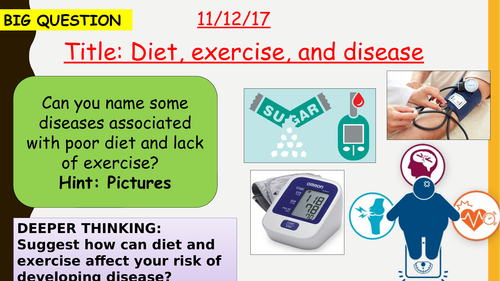
Diet, exercise and disease lesson created in accordance to the NEW AQA Specification (9-1). Designed for a higher ability class, although content can be adjusted to suit any ability. Includes powerpoint timers, slide animations, embedded video's, worksheet and mini review. NB: If you are unable to play embedded videos please view slide notes for link.
AQA spec link: 4.2.2.6
Relevant chapter: B7 Non-communicable diseases. AQA Biology combined textbook-Page 104-105
Students are required to know the following;
• discuss the human and financial cost of these non-communicable diseases to an individual, a local community, a nation, or globally
• explain the effect of lifestyle factors including diet, alcohol, and smoking on the incidence of non-communicable diseases at local, national, and global levels.
Risk factors are linked to an increased rate of a disease. They can be:
• aspects of a person’s lifestyle
• substances in the person’s body or environment.
A causal mechanism has been proven for some risk factors, but not in others.
• The effects of diet and exercise on cardiovascular disease.
• Obesity as a risk factor for Type 2 diabetes.
Many diseases are caused by the interaction of a number of factors.
Students should be able to understand the principles of sampling as applied to scientific data in terms of risk factors. Students should be able to translate information between graphical and numerical forms; and extract and interpret information from charts, graphs and tables in terms of risk factors. Students should be able to use a scatter diagram to identify a correlation between two variables in terms of risk factors.
AQA spec link: 4.2.2.6
Relevant chapter: B7 Non-communicable diseases. AQA Biology combined textbook-Page 104-105
Students are required to know the following;
• discuss the human and financial cost of these non-communicable diseases to an individual, a local community, a nation, or globally
• explain the effect of lifestyle factors including diet, alcohol, and smoking on the incidence of non-communicable diseases at local, national, and global levels.
Risk factors are linked to an increased rate of a disease. They can be:
• aspects of a person’s lifestyle
• substances in the person’s body or environment.
A causal mechanism has been proven for some risk factors, but not in others.
• The effects of diet and exercise on cardiovascular disease.
• Obesity as a risk factor for Type 2 diabetes.
Many diseases are caused by the interaction of a number of factors.
Students should be able to understand the principles of sampling as applied to scientific data in terms of risk factors. Students should be able to translate information between graphical and numerical forms; and extract and interpret information from charts, graphs and tables in terms of risk factors. Students should be able to use a scatter diagram to identify a correlation between two variables in terms of risk factors.
Get this resource as part of a bundle and save up to 20%
A bundle is a package of resources grouped together to teach a particular topic, or a series of lessons, in one place.
Something went wrong, please try again later.
Report this resourceto let us know if it violates our terms and conditions.
Our customer service team will review your report and will be in touch.
£3.00
